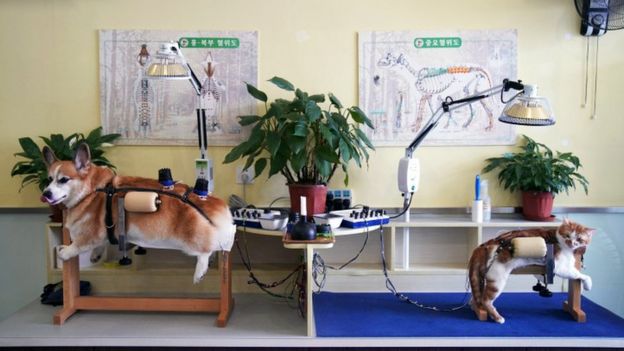You have probably heard of
acupuncture for humans, but the ancient Chinese therapy is growing in
popularity among pet owners too as a holistic supplement to traditional
veterinary care.Just like with people, small needles are
inserted into the animals' skin at defined points to try and relieve
pain through stimulated blood circulation.
In cats and dogs it is
most commonly used in musculoskeletal and chronic pain ailments such as
arthritis or gastrointestinal issues.
It emerged several decades ago but remains an unconventional and alternative therapy method that most vets don't use.
The International Veterinary Acupuncture Society (IVAS) now has about 1,900 members, and they are
holding a conference in Cairns, Australia this week with practitioners from 21 countries.
But like with acupuncture in human medicine, a great deal of scepticism surrounds the practice in pets. A
2006 study
said "there is no compelling evidence to recommend or reject
acupuncture" in veterinary medicine because of inconclusive and limited
research.
But thousands of owners and practitioners swear the procedure is
making a difference to the quality of pets' lives - especially elderly
and chronically ill animals.
One mainstream theory in acupuncture research is this
temporary pain relief stems from the release of a natural painkiller called adenosine around the insertion point.
Critics maintain that the improvements owners see are a transfer of a "placebo effect" to the observer.
Lara Sypniewsk, a Clinical Professor of Small Animal Medicine at Oklahoma University, is a vocal advocate of the practice who
held a TedxTalk on the subject.
Speaking
to the BBC, she explained she first sought the treatment for animals
that weren't able to use traditional pain relief medication because of
pre-existing liver and kidney conditions.
"Our animals' role in
our lives has changed tremendously - they used to sleep outside and now
the husband is being kicked out bed to make room for the dog," she said.

"Preventative
medications mean animals are living a lot longer. Acupuncture is just
one part of wider treatment plan to make suffering animals comfortable
so they can enjoy their life.
"The growing popularity is definitely client driven, people ask me if
there's something that can be done to reduce the drug doses their pets
are being given.
"A 100% of people are sceptical in the beginning, but quickly become flabbergasted by the results."
Reuters
spoke to vet Jin Rishan in Shanghai
who said he had treated more than 2,000 family pets since the clinic
opened in 2013. He claimed up to 80% of animals had seen an improvement
after treatment.
Critics maintain that the improvements observed are a transfer of a "placebo effect" to the pet owner.
Liv Wills from Hertfordshire in England posted pictures on social
media of her 15-year-old cat Barney calmly having acupuncture after a
vet suggested it could help his worsening digestive problems.
"He had 14 needles, including one on his nose and he didn't even flinch. He instantly relaxed," she said.
"I'd never heard of it in animals before, but me and my mum couldn't
believe how calm he acted. Usually after the vet he would be moody, but
he came up and lay down relaxed in the hall.
"The effects haven't been that dramatic, but we booked him in for two more sessions after he got a bit of his appetite back."
In the US, pharmaceutical companies for animals are now multi-billion
dollar industries as owners try to extend the quality and length of
their pets' lives.
But in 2015 the American Animal Hospital
Association (AAHA) and American Association of Feline Practitioners
(AAFP) issued joint guidelines that labelled acupuncture a "compelling
and safe method for pain management" that "should be strongly
considered" as part of a pain management plan in pets.
The
guidance leads many to think alternative therapies like acupuncture,
hydrotherapy and chiropractic care could become more popular throughout
world veterinary medicine in the future.
(Source-BBC)











